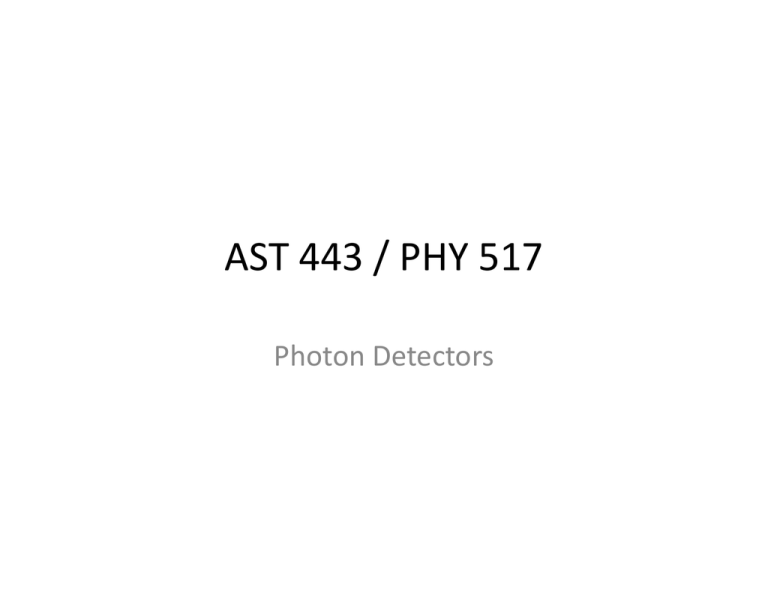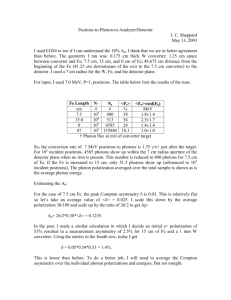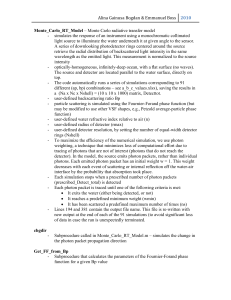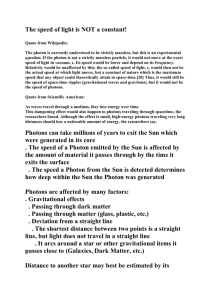Document 11143712
advertisement

AST 443 / PHY 517 Photon Detectors Photons Light is electro-­‐magne>c radia>on • Crossed electric and magne>c vectors • Self-­‐propaga>ng • Travels at speed of light c • c=2.99792 x 108 m/s (vacuum) • λν = c • n=c/vlight Photons • Light has characteris>cs of both waves and par>cles • At long wavelengths (sub-­‐mm, radio), the wave characteris>cs dominate. • At wavelengths up to and including the mid-­‐IR (10s of μms), light is best thought of a discrete photons – a self-­‐bounded packet of energy. • E=hν=hc/λ h=6.62 x 10-­‐27 erg s (Planck’s constant) Units Energy • 1 erg = 10-­‐7 J • 1 eV = 1.60 x 10-­‐12 erg • 1 keV = 103 eV =1.60 x 10-­‐9 erg Energy Density • Jy = 10-­‐26 J / (m2 s Hz) = 10-­‐23 erg / (cm2 s Hz) • Jy = 3.34 x 104λ2 Fλ erg/(cm2 s A) • Jy = 6.34 x 10-­‐4λ fλ photons/(cm2 s A) Basic Detec>on Schemes • Antenna: radia>on makes electrons oscillate – Appropriate at radio wavelengths – Generally analog devices • Bolometer: detect absorbed energy – Can be either analog or digital • Photon-­‐counter: detect individual photons – Requires high >me resolu>on, or low photon rates – Generally digital Electromagne>c Radia>on Electromagne>c “Domains” • Gamma-­‐ray: E>100 keV. hard to focus. • X-­‐ray: defined by detector technology. Originally 2-­‐6 keV. – Hard X-­‐rays: >10 keV (<1 A) – Sol X-­‐rays: <0.25 keV (<44 A) • Extreme UltraViolet: between sol X-­‐rays and ~ 912 A. – Needs window-­‐less detectors • UltraViolet: 912 A to atmospheric cutoff (3200 A) • Op;cal: 3200 A – about 1 micron (10,000 A). (Roy G Biv) • IR: >8000 A to ~100 microns – near-­‐IR: <5μm – mid-­‐IR: ~5-­‐50μm • Sub-­‐mm/mm: ~100 microns – 1 cm • Radio: λ > 1 cm ν<30 GHz Photon Detectors Considera;ons in a detector • Quantum Efficiency (QE): What frac>on of the incident photons are detected? • Noise: Does the detector add photons or electrons to the signal? • Time Resolu;on: How fast can the detector count? • Energy Resolu;on: How well can you determine the total energy? • Pixel size (spa;al resolu;on): How well can you localize the posi>on? • Dynamic Range: what is the brightest and faintest signal that can be detected in the same exposure? • Response/bandpass: set by product of QE, filter response, telescope throughput • Size of field: How many pixels? The Eye The Eye as a Simple Lens The Eye -­‐ a simple, versa>le detector with a complex data processor • A digital detector. Does not integrate. Time resolu>on ~ 13 msec. • Lens focuses on curved re>na • Dynamic Range: ~109-­‐10 – ~108 rods provide high sensi>vity at low light levels (QE~1). – Rods insensi>ve to red light. – Entrance pupil expandable to about 5 mm. – ~6 million cones concentrated at field center provide color sensi>vity – Peak sensi>vity ~ 5500 A (QE~0.01). • Faint limit: typically V~6 (~300 photons in 0.1 seconds) • Rayleigh limit:~ 20 arcsec (but actual resolu>on about 1.2' due to density of re>nal cells; 5-­‐10' off-­‐axis due to aberra>ons.) • Opera;on: Photon energy deposi>on alters structure of Rhodopsin, which changes the permeability of the cell membrane and sends a signal to the brain. Photography • Invented about 1840 • Large format • stable detectors (glass substrate) • Good storage medium • Low QE, <1-­‐2% • Long integra>ons possible • non-­‐linear response (the characteris>c curve) • Limited dynamic range • Sensi>vity/spa>al resolu>on tradeoff Photography: the Characteris>c Curve The Photographic Process • Ag halide grains suspended in gel • Ag halide absorbs photon -­‐> e-­‐, hole pair • e-­‐ moves from valence band to conduc>on band, and neutralizes Ag+ ion • Grains of ~100 Ag atoms form latent image. • Developer converts Ag halides to Ag, but is catalyzed by neutral Ag (the latent image). • Latent image is amplified ~ 109 >mes. • Fixer removes remaining Ag halide Photographic Plate Collec>ons Plates were the primary astronomical detector un>l the 1980s • Harvard plate stacks – Over 525,000 glass plates – Taken 1885 – 1993 – Par>ally digi>zed • Strasbourg plate stacks • Many observatories have small collec>ons Bolometers • • • • Resis>vity in a metal is a func>on of temperature Place conductor inside a heat bucket Measure change in resis>vity First use: 1880 Bolometers Examples: • ACRIM: measure solar constant • DIRBE • Herschel SPIRE Advantages: • Simple • High QE Photomul>pliers Uses the Photoelectric effect • Photon ejects electron from photo-­‐emissive surface • Electron is amplified 106 – 109 >mes • Detec>on of current -­‐> detec>on of single photon. Photomul>plier Tubes • Good >me resolu>on (micro-­‐seconds) • No spa>al resolu>on (make an array!) • Generally no energy resolu>on • No dynamic range • Short wavelength cutoff set by window/filter • Long wavelength limit set by work func>on – NaCl: 150 nm – CsSb: 700 nm – GaAs: 1000 nm Semi-­‐conductor Detectors Photon can: • eject electron from metal, or • from valence band to conduc>on band Photon-­‐coun>ng Imaging Systems • A photomul>plier using photo-­‐emissive surfaces • Read as a TV in reverse Charge Coupled Devices Charge Coupled Devices, or CCDs, are the workhorse of op>cal astronomical instrumenta>on. For many purposes they are as close to an ideal detector as we can get. CCDs feature: • High QE • low instrumental noise (read noise) • stable response • good fla{enability • large dynamic range (generally > the 16 bit digi>za>on) linear response small pixels (typically 15 -­‐ 24 microns) • large format (up to 40962 pixels) • can be >led CCDs Conceptually CCD Clocking CCD Limita>ons • Small formats • Slow readouts – Faster readout -­‐> more read noise • Generally not photon-­‐coun>ng in op>cal • Imperfect Charge Transfer Efficiency (CTE) • Deferred charge /traps/ blooming • Digi>za>on limits • Non-­‐uniform responses Spa>al Resolu>on • CCD pixel size limited by manufacturing process – Typically 15-­‐24 microns • Plate scale = 1/fl • Pixel scale = size/fl – For HST, effec>ve fl ~ 57.6m; D=2.4m – Arcsec/pix = 24 μm/57.6 x 106 μm x 206265 ~ 0.09”/
pix – HST resolu>on: – R = 1.22 λ/D = 0.06” at 5500A CCD Quantum Efficiency









